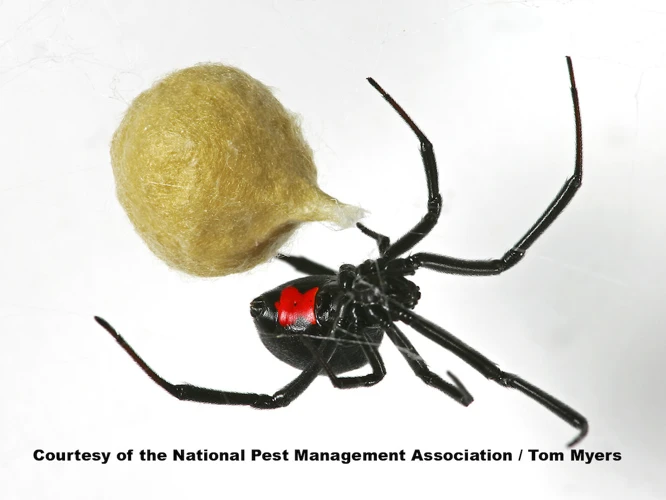Introduction
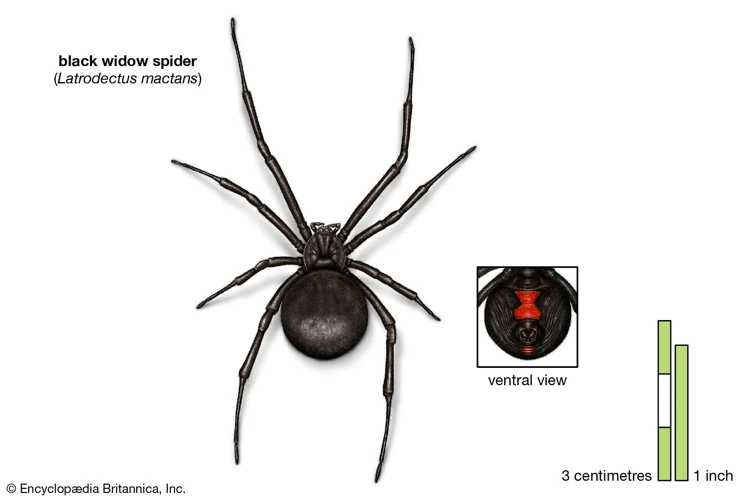
Starting off our comprehensive overview on the presence of Black Widow Spiders in South America, we delve into the world of one of the most feared spiders on the planet. Known for their poisonous bites, these spiders have garnered a reputation that often precedes them. However, there is much more to these fascinating creatures than meets the eye. In this article, we will explore their habitat, behavior, identification, life cycle, potential dangers, and much more. So, let’s take a deep dive into the world of Black Widow Spiders in South America.
Overview of Black Widow Spiders
The Black Widow Spider is one of the most notorious and recognizable arachnids in the world. The species is scientifically known as Latrodectus, which is derived from Greek meaning “bite of the Latrodecta”. The name is appropriate as the spider is well known for its painful and venomous bite, which can cause serious medical complications. Black Widow Spiders are found throughout the world, and are indigenous to every continent except for Antarctica. However, they are most commonly associated with the Americas, particularly North and South America.
One of the most distinguishing features of the Black Widow Spider is the female’s propensity for cannibalizing her mate after copulation. However, this behavior is limited to certain species within the genus, and is uncommon in South American populations. Black Widow Spiders predominate in different habitats, such as forests, deserts, and suburban environments. Nevertheless, they prefer warm and dry climates and typically avoid cold, wet, and windy areas.
The Black Widow Spider has distinct appearance, its most recognizable feature is its red hourglass-shaped marking on the underside of the abdomen. The coloration of the spider can vary from jet black to dark brown to light brown, with white stripes or spots appearing in some species. They have a bulbous abdomen, which is often compared to a sphere or a globe. The male Black Widow Spider is smaller and less conspicuous than the female and usually has lighter or browner coloration.
The Black Widow Spider’s reputation as a dangerous and venomous predator is well deserved. However, it is important to note that they typically only bite humans in self-defense and usually retreat if confronted. In the following sections of this article, we will explore the different aspects of the Black Widow Spider’s habitat, behavior, identification, life cycle, and potential dangers and treatment.
Habitat and Distribution
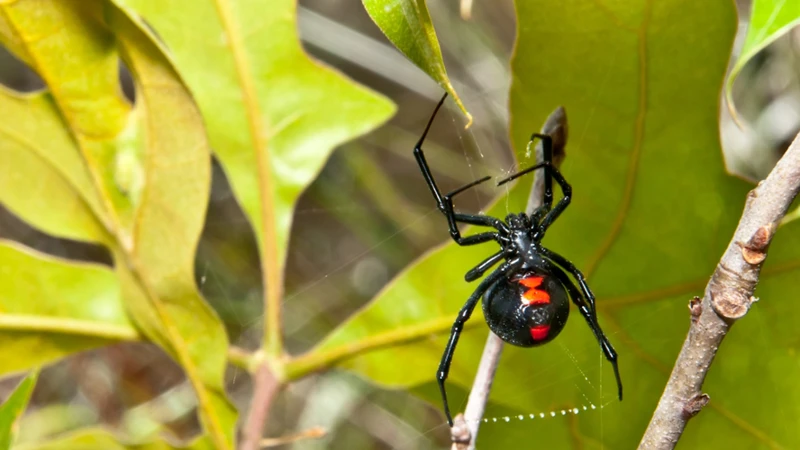
The distribution and habitat of black widow spiders have long been the subject of fascination and fear. These notorious and venomous spiders are native to many regions of the world, including North America, Asia, and South America. However, in this article, we’ll be focusing specifically on the habitat and distribution of black widow spiders in South America. So, let’s dive into the details and explore where these spiders can be found and the kind of habitat they prefer.
South American Countries with Black Widow Spider Population
South America is home to a variety of black widow spider species, which are primarily found in Argentina, Brazil, Chile, Ecuador, Peru, Uruguay, and Venezuela. These countries have a range of climates, from tropical to temperate, but black widow spiders can thrive in a variety of habitats.
In Argentina, the Latrodectus mactans species is commonly found in the northern provinces, while the Latrodectus mirabilis species is found in the southern provinces. Brazil has a variety of black widow species, including Latrodectus curacaviensis, Latrodectus hesperus, and Latrodectus geometricus, which are found in different areas of the country. In Chile, the Latrodectus mactans species can be found in the central regions, while in Ecuador, the Latrodectus mactans and Latrodectus geometricus species are present.
In Peru, the Latrodectus antheratus species is found in the central and northern regions, while in Uruguay, the Latrodectus mirabilis and Latrodectus curacaviensis species are present. Venezuela is home to the Latrodectus geometricus species, which is found throughout the country. Despite their prevalence in South America, black widow spider populations can vary from region to region, and more research is needed to fully understand their distribution and habitat preferences.
If you want to learn more about black widow spiders, check out our article on black widow spiders in North America or our piece on global black widow spider populations.
Preferred Habitat and Nesting Sites
Black Widow Spiders are known to thrive in a variety of environments, and their preferred habitats and nesting sites can vary based on several factors such as climate, altitude, and geographic location. According to research, these spiders tend to prefer warm and dry environments, which is why they can be commonly found in rocky areas, crevices, and dry foliage. They are also known to inhabit man-made structures such as sheds, barns, and other outdoor structures.
Preferred Habitat
Black Widow Spiders prefer to live in locations that are shielded from the sun, wind, and rain. Hence, they are most commonly found in dark and sheltered environments, such as garages, sheds, and other man-made buildings. These areas provide them with the necessary protection from the elements, while also offering ample opportunity to hunt for prey.
Nesting Sites
The nesting sites of Black Widow Spiders also vary depending on their geographic location. In South America, they are often found in underground burrows, rock crevices, and hollow tree trunks. They have also been known to spin webs in dark and inaccessible locations such as attics, basements, and crawlspaces.
To locate their preferred nesting sites, Black Widow Spiders rely on a variety of cues, such as temperature, humidity, and prey availability. They also exhibit a remarkable ability to adapt to changing conditions, which allows them to survive in a wide range of environments.
Black Widow Spiders are highly adaptable and can thrive in a variety of environments. Their preferred habitats and nesting sites vary based on several factors, including climate, altitude, and geographic location. To learn more about the habitats of Black Widow Spiders, check out our article on habitats of Black Widow Spiders, or see our map of Black Widow Spider distribution.
Behavior and Diet
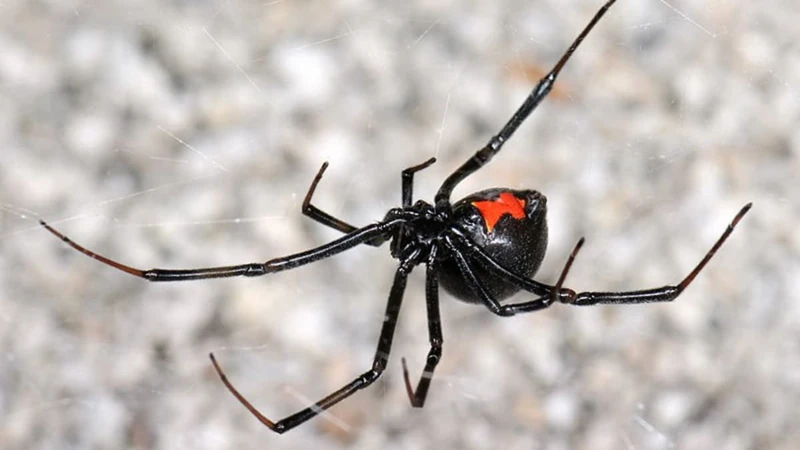
The behavior and diet of black widow spiders are fascinating to observe. These spiders have unique hunting habits and feeding preferences that are important to understand to avoid any potential dangers. In this section, we will delve into the world of black widow spiders, exploring their web-building habits and preferred prey choices. We will also discuss how their behavior can vary depending on their habitat and nesting sites. So, let’s take a closer look at the fascinating behavior and diet of these venomous spiders. If you want to learn about the potential future distribution of black widow spiders due to climate change, check out this article.
Web-Building and Hunting Habits
Black Widow Spiders are known for their distinctive and intricate webs, which they use for both hunting and shelter. Their web-building habits can vary depending on their habitat and available resources. Typically, they build their webs in secluded and dark areas, such as in between rocks, in tree stumps, or in sheds.
Black Widows are nocturnal and prefer to hunt at night, using their webs to trap prey. Their webs are sticky and strong, making it difficult for their prey to escape. When prey gets stuck, the Black Widow quickly immobilizes it with its venomous bite.
Interestingly, Black Widows can recycle their webs up to 20 times, as long as their current web isn’t completely destroyed. They will add fresh silk to reinforce their existing web and make necessary repairs.
Some species of Black Widows are known to build their webs closer to the ground to avoid windy conditions, while others build their webs higher up in trees to capture flying insects. In some areas, Black Widows may even build communal webs with other spiders.
It’s important to note that not all Black Widow Spiders build webs for hunting. Some species are known to be more active hunters, stalking their prey instead of relying on a trap. The hunting habits of Black Widows can vary depending on factors such as climate, altitude, and availability of prey.
The web-building and hunting habits of Black Widow Spiders are fascinating and unique. However, it’s important to exercise caution and stay informed about the potential dangers of encountering these spiders. Visit the link to learn more about the risks associated with Black Widow bites in different regions of the world.
Feeding Preferences and Prey
Among the many dangers posed by Black Widow Spiders is their feeding preference. These creatures are carnivorous and mainly consume insects, other spiders, and arthropods. They prey on a wide range of insects including mosquitoes, flies, beetles, grasshoppers, and even cockroaches. Black Widow Spiders also feast on other spiders, including males of their own species, and have been known to consume scorpions and centipedes on occasion.
Interestingly, Black Widow Spiders do not actively hunt for prey but rather, build webs in strategic locations, which they use to catch passing insects. They have poor eyesight and rely on their webs’ vibrations to detect prey. Once caught, the Black Widow Spider quickly immobilizes the prey by wrapping it in webbing. They then bite the prey, injecting it with venom and digestive enzymes that liquefy the prey’s internal organs.
Black Widow Spiders do not feed every day, but rather in a cyclical pattern where they devour large amounts of food in a single feeding and then fast for several days until they are ready to feed again. They are also able to survive for extended periods without food, particularly in cooler climates where their metabolism slows down.
It is worth noting that while Black Widow Spiders mainly eat insects and other spiders, they do not discriminate and will attack and eat animals larger than themselves if a suitable opportunity presents itself. There are also instances where they have been known to cannibalize males of their own species, particularly during the mating season.
It is essential to take precautionary measures when dealing with Black Widow Spiders, especially in areas where their population is high, such as South America. For more information about the distribution of Black Widow Spiders in different parts of the world, check out our related articles such as ‘Distribution of Black Widow Spiders in Asia‘ and ‘Suburban Black Widow Spiders‘. It is also recommended to take measures to control insects and other arthropods in and around your home to minimize the possibility of attracting Black Widow Spiders.
Identification and Characteristics
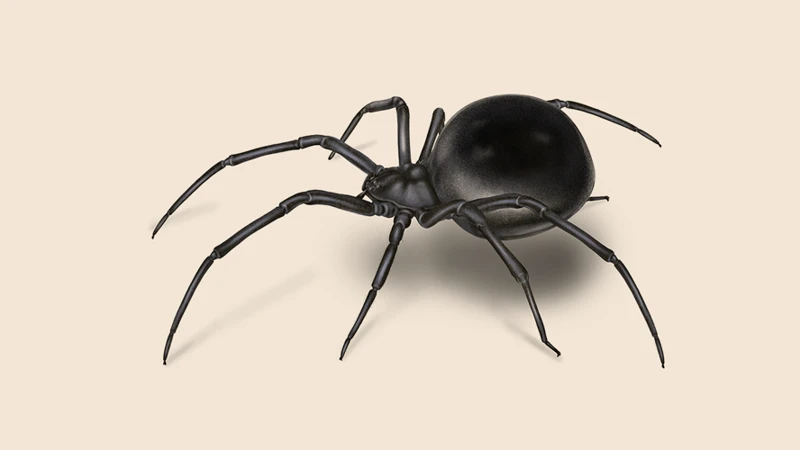
When it comes to identifying the Black Widow spider, there are quite a few notable characteristics to look for. These spiders are notoriously recognized for their distinctive appearance and can be found inhabiting various environments across South America. From their size and coloration to their unique hourglass-shaped marking, let’s dive deeper into what makes this spider one of the most recognizable arachnids in the world.
Physical Features and Coloration
Black widow spiders have a distinct appearance that sets them apart from other spider species. Here are some of their physical features and coloration:
- Size: Adult female black widows are typically about half an inch to 1.5 inches in body length, while males are generally smaller and slimmer.
- Coloration: The black widow spider’s body is usually shiny black, with red or orange markings on the underside of the abdomen. These markings can vary in shape and size, but most female black widows have a distinctive hourglass-shaped marking that is either red or bright yellow. Some black widow populations may have more muted markings or even lack them entirely.
- Body shape: Black widow spiders have a round, bulbous abdomen that is much larger than their cephalothorax (the combined head and thorax region). Their legs are long and slender, allowing them to move quickly and gracefully.
- Webs: Black widows spin irregular webs that are often found in dark, sheltered locations such as woodpiles, sheds, and other outdoor structures. Their webs are sticky and strong, allowing them to catch prey easily.
It’s important to note that the appearance of black widow spiders can vary depending on several factors, including their location, elevation, and climate. For example, black widows that live in cooler climates may have lighter coloration or smaller bodies than those found in warmer areas. Similarly, black widows that live at high altitudes may have adapted to their environment by developing smaller bodies and longer legs to help them move more easily in thin air. To learn more about these adaptations, check out our articles on climate and black widow spiders or altitude and black widow spiders.
Distinctive Hourglass-Shaped Marking
The distinctive hourglass-shaped marking on the black widow spider’s abdomen is a well-known characteristic that helps to identify the species. The hourglass shape is created by a red or orange spot on the ventral side of the abdomen, usually near the rear of the spider. This marking is most commonly found on female black widows but can also be present on juveniles and males, although it is often less distinct.
The hourglass marking is sometimes described as an “hourglass figure” due to its similar shape. It is an important identifying feature as it helps to differentiate black widows from other similar-looking spiders. However, it is important to note that not all black widows have a clear hourglass shape, and some individuals may have markings that are more difficult to discern.
To better understand the distinctive hourglass-shaped marking, refer to the following table:
| Feature | Description |
|---|---|
| Shape | The hourglass marking is a distinct red or orange spot on the ventral side of the black widow spider’s abdomen that is shaped like an hourglass. |
| Location | The marking is usually located near the rear of the spider’s abdomen and can be found on females, juveniles, and males. However, it is often less distinct on males and juveniles. |
| Coloration | The hourglass marking is typically red or orange in color, but may appear slightly different depending on the individual spider and lighting conditions. |
| Importance | The hourglass-shaped marking is an important identifying feature that helps differentiate black widows from other similar-looking spiders. |
It’s important to note that while the hourglass marking is a distinctive feature of the black widow spider, it should not be relied on solely for identification purposes. Other physical features, such as the spider’s body shape, color, and leg length, should also be considered when trying to identify a black widow.
Similar Species and Common Misconceptions
There are several species of spiders that may be mistaken for black widows, leading to common misconceptions about their presence in South America. Here is a comparison table of similar species and their distinguishing features:
| Species | Distinguishing Features |
|---|---|
| Redback Spider | Found in Australia, has a red dorsal stripe instead of an hourglass marking, females also have a broader body shape and males have a more elongated shape |
| Brown Widow Spider | Found in North and South America, has a distinctive white or yellowish-orange hourglass marking on a brown or gray body, may have a spotted or streaked appearance |
| Southern House Spider | Found in the southeastern United States and South America, has a similar body shape and coloration to black widows but lacks the hourglass marking, creates webs in corners and crevices indoors |
| False Widow Spider | Found in Europe and North America, has a similar body shape and coloration to black widows but typically lacks the distinctive hourglass marking, may have a white or cream-colored dorsal stripe instead, less venomous than black widows |
It’s important to note that while these species may share some physical similarities with black widows, they are not as venomous and may not pose as much of a threat to humans. However, it’s still important to exercise caution and avoid handling any spiders in the wild, as bites from even non-venomous spiders can still cause irritation and infection.
Life Cycle and Reproduction
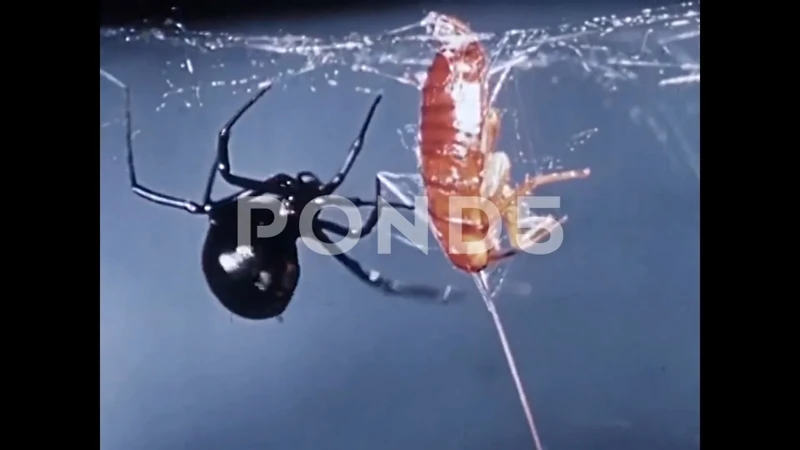
The life cycle and reproductive habits of black widow spiders are fascinating and intricate. From the hatching of their eggs to the maturation of their offspring, these creatures go through several stages of development. In this section, we will delve into the various aspects of their life cycle and discuss their unique reproductive behaviors. So let’s explore the remarkable journey of black widow spiders from birth to adulthood.
Egg Hatching and Early Development
After mating, the female black widow spider lays her eggs in a silken sac. Each sac can contain up to 750 eggs. The sac is then protected by the female spider and eventually hatch within a month.
Early Development
Once the eggs hatch, spiderlings emerge from the sac and immediately disperse. These spiderlings are tiny, measuring only about 1/10th of an inch in length. They go through several molts before they reach maturity. During this time, the spiderlings rely on their own instincts to hunt and capture prey for survival.
Maturation
Black widow spiderlings typically take around three to four months to fully mature. Once they are fully grown, black widow spiders can reach a length of up to 1.5 inches. Females are typically larger than males, and have a longer lifespan.
Mating and Reproduction
At around one year of age, male black widows will begin to search for mates. During mating, the smaller male must approach the larger female with extreme caution to avoid being eaten. After successful mating, the female can produce up to nine more egg sacs throughout her life, with each containing hundreds of eggs.
Here is an HTML table for a summary of the egg hatching and early development process of black widow spiders:
| Process | Details |
|---|---|
| Egg Laying | The female black widow spider lays up to 750 eggs in a silken sac. |
| Egg Hatching | Black widow spider eggs usually hatch within a month inside the sac. |
| Early Development | Spiderlings immediately disperse after hatching and go through several molts before reaching maturity. |
| Maturation | Black widow spiderlings typically take around three to four months to fully mature. |
| Mating and Reproduction | At one year of age, male black widows will begin to search for mates. After mating, the female can produce up to nine more egg sacs throughout her life. |
Molting and Maturation
As black widow spiders mature, they undergo several molting stages known as instars. In simpler terms, it is a process where the spider sheds its exoskeleton to grow and develop into its next stage. This molting process is essential for the spider’s maturation, and each molting stage takes the spider closer to its adult form.
During molting, the spider’s old exoskeleton splits along predetermined lines, and the spider works at wiggling out of its old outer layer. After completing this process, the spider is left soft and vulnerable for a few hours to a day, while its new exoskeleton hardens and darkens.
Molt frequency and duration. Black widow spiders undergo several molting stages before reaching adulthood. The exact number of molts depends on several factors, including the spider’s gender, nutrition, and living conditions. On average, black widow spiders go through five to ten instars before their final molt.
The molting stages vary in duration depending on the spider’s maturity level. Young spiders will molt more frequently than adult spiders, and the molting process takes longer for adults as they have more mass to shed. Molting typically occurs once every few weeks to a few months, depending on the spider’s age and food availability.
Maturation and reproductive readiness. Once black widow spiders reach maturity, they are ready to mate and reproduce. Males typically mature faster than females, and once they have reached sexual maturity, they will start seeking receptive females to mate.
Females, on the other hand, may take longer to mature, but once they reach maturity, they tend to be larger and more robust than males. After molting into their adult form, female black widow spiders are capable of producing eggs and laying them in their webs. They can produce several egg sacs throughout their lifetime, each containing up to several hundred eggs.
Molting and maturation are crucial phases in a black widow spider’s life cycle. The molting process allows the spider to shed its old exoskeleton and grow into its next developmental stage. Once they reach maturity, black widows are ready to reproduce and potentially produce hundreds of offspring. Understanding the molting and maturation process gives us a better insight into the life cycle and reproductive behavior of these fascinating spiders.
Mating and Offspring Production
One interesting aspect of the black widow spider’s life cycle is their mating and offspring production. Male black widows are generally smaller than females and have distinctive red or yellow markings on their backs. In order to mate, males approach females with caution and vibrate their webs to signal their presence and intentions.
Once a male has successfully mated with a female, she will lay fertilized eggs in a silk sac. The number of eggs can range from a few dozen to several hundred, depending on the species of black widow. The female spider will then guard the sac until the eggs hatch and the spiderlings emerge.
Table: Typical Reproductive Characteristics of Common Black Widow Species in South America
| Spider Species | Number of Eggs per Sac | Time for Eggs to Hatch | Number of Clutches Per Year |
|---|---|---|---|
| Latrodectus geometricus | Approximately 150-200 | 25-30 days | 2-3 |
| Latrodectus curacaviensis | Approximately 250-350 | 25-30 days | 2-3 |
| Latrodectus corallinus | Approximately 100-200 | 25-30 days | 1-2 |
It is important to note that while the female black widow spider is known for her venomous bite, she is also vital to the survival of her offspring. The mother spider will provide her young with food until they are able to hunt on their own, and she will sometimes even allow her spiderlings to feed on her if necessary.
The reproductive process of black widow spiders in South America is a fascinating and intricate part of their life cycle, highlighting the importance of these creatures in their ecosystem.
Potential Dangers and Treatment
When it comes to the black widow spider, potential danger is always a concern. While these arachnids are not aggressive towards humans, their venom can be incredibly dangerous if left untreated. It’s important to be aware of the symptoms of a black widow spider bite and take action quickly if you suspect you’ve been bitten. In this section of the article, we’ll explore the potential dangers posed by these spiders and the available treatments.
Symptoms of Black Widow Spider Bite
Black Widow Spider bites can cause a range of symptoms, varying in severity from mild discomfort to life-threatening complications. It is important to identify the symptoms of a Black Widow Spider bite, as prompt treatment can play a crucial role in mitigating the damage caused by the venom. Below is a detailed list of the potential symptoms of a Black Widow Spider bite:
| SYMPTOM | DESCRIPTION |
|---|---|
| Pain | Sharp, burning pain around the bite site that may radiate outward to other parts of the body. |
| Redness and Swelling | The bite area may become red, swollen, and warm to the touch. |
| Sweating | Excessive sweating, particularly in the affected area or all over the body. |
| Nausea and Vomiting | Feeling sick to the stomach and vomiting. |
| Muscle Cramps | Twitching or cramping of the muscles, particularly in the abdomen. |
| Headache | Persistent headache, sometimes accompanied by dizziness or weakness. |
| Fever | A low-grade fever may develop, and the area around the bite may feel warm to the touch. |
| Severe Symptoms | In rare cases, severe symptoms may occur, including seizures, muscle paralysis, and difficulty breathing. Seek medical attention immediately if you experience any of these symptoms. |
It is important to note that not all Black Widow Spider bites will display the same symptoms. The severity and duration of the symptoms may vary depending on the age and health of the individual, as well as the amount of venom injected during the bite. If you suspect that you or someone you know has been bitten by a Black Widow Spider, it is essential to seek medical attention immediately.
Preventive Measures and First Aid
Taking preventive measures to avoid Black Widow Spider bites is key to staying safe. Here are some tips to keep in mind:
- Be alert: Black Widow Spiders thrive in areas with ample cover, such as woodpiles, sheds, and cluttered areas. Be cautious when working in these environments and keep an eye out for any spiders.
- Wear protective clothing: When working in places with a high risk of encountering Black Widow Spiders, it’s a good idea to wear long sleeves, pants, and gloves to prevent bites.
- Use insecticides: Regular use of insecticides around areas like the perimeter of a home and storage sheds will help reduce the population of Black Widow Spiders.
- Inspect camping gear: Inspect camping equipment and any outdoor gear for spiders before and after use. Shake out clothing and bedding and check shoes before putting them on.
In the event of a Black Widow Spider bite, quick first aid can help limit the severity of symptoms. Here’s what you should do:
- Wash the bite: Rinse the bite area thoroughly with soap and warm water to remove venom that hasn’t entered the bloodstream.
- Reduce swelling: Apply a cold compress, such as a wrapped ice pack or a bag of frozen vegetables, to the bite area for 10 minutes and then take a break for 10 minutes. Repeat as needed.
- Take pain relief medication: Over-the-counter pain relief medication such as ibuprofen or acetaminophen can help relieve pain and reduce inflammation.
Note: Seek medical attention immediately if the symptoms are severe, including severe pain, muscle spasms, chest pain, difficulty breathing, or abdominal pain. Antivenom may be necessary to treat a serious Black Widow Spider bite.
Medical Treatment and Antivenom
In the event of a black widow spider bite, medical treatment should be sought immediately. The severity of the symptoms can vary, but it is better to err on the side of caution and seek medical attention as soon as possible.
Treatment Options:
There are several treatment options available for black widow spider bites. These include:
| Treatment | Description |
|---|---|
| Wound Care | The wound should be cleaned with soap and water to prevent infection. Ice can be applied to the affected area to help reduce swelling and pain. |
| Pain Relief | Over-the-counter pain medications like ibuprofen or acetaminophen can be taken to help manage pain. |
| Antivenom | Antivenom is the most effective treatment for black widow spider bites. It is administered by injection and works by neutralizing the spider’s venom. Antivenom is only available in hospitals. |
Antivenom:
Antivenom is a specialized serum that is specifically designed to neutralize the venom of black widow spiders. It is only available in hospitals and can be administered by injection. Antivenom is usually reserved for severe cases of black widow spider bites, as it can cause allergic reactions and other side effects.
Side Effects:
While antivenom is an effective treatment for black widow spider bites, it can cause side effects. These include:
- Allergic reactions
- Nausea and vomiting
- Fever and chills
- Headache
- Dizziness
It is important to discuss the risks and benefits of antivenom with a healthcare professional before it is administered.
Conclusion
In conclusion, the presence of black widow spiders in South America is a reality that cannot be ignored. These spiders are widely distributed across the continent, with populations in many different countries. Their preferred habitats and nesting sites include urban and rural areas alike, making them a common sight in many parts of the region.
Despite their somewhat fearsome reputation, black widow spiders are an important part of the South American ecosystem. They are skilled hunters, using their webs and stealthy tactics to capture prey. They also play a role in controlling the populations of other insects and arachnids, which helps to maintain the balance of the local environment.
However, it is important to recognize the potential dangers associated with black widow spiders. Their venom can be extremely potent, and bites can have serious consequences. It is recommended to take preventative measures to avoid contact with these creatures, and to seek medical treatment if a bite occurs.
Overall, a comprehensive understanding of black widow spiders in South America is essential for anyone who lives or works in the region. By knowing more about these creatures and how to avoid them, we can ensure that we stay safe while also appreciating the important role they play in our ecosystem.
Frequently Asked Questions
Q: Are all black widow spiders venomous?
A: Yes, all black widow spiders are venomous. However, only the females pose a threat to humans.
Q: What is the most common species of black widow spider found in South America?
A: The most common species of black widow spider found in South America is the Latrodectus geometricus.
Q: What is the preferred habitat of black widow spiders?
A: Black widow spiders prefer to live in warm and dry environments such as deserts, forests and fields. They tend to nest in dark and undisturbed areas such as woodpiles, sheds, and under rocks.
Q: Can black widow spiders be found in urban areas?
A: Yes, black widow spiders can be found in urban areas, especially in the southern regions of South America where the weather conditions are favorable for them.
Q: What do black widow spiders eat?
A: Black widow spiders feed on a variety of insects such as flies, mosquitoes, and grasshoppers.
Q: Are black widow spiders aggressive towards humans?
A: Black widow spiders are very shy and usually only bite humans when threatened or provoked.
Q: What is the distinctive hourglass-shaped marking on black widow spiders?
A: The distinctive hourglass-shaped marking on black widow spiders is a bright red or orange spot on the underside of the abdomen.
Q: Can people die from black widow spider bites?
A: While deaths from black widow spider bites are rare, it is still important to seek medical attention if bitten as the venom can cause serious symptoms.
Q: What should I do if I encounter a black widow spider?
A: If you encounter a black widow spider, it is best to leave it alone and avoid provoking it.
Q: How can I prevent black widow spider bites?
A: You can prevent black widow spider bites by wearing gloves and long sleeves when working outside, shaking out clothing and shoes before wearing them, and keeping your living space clean and clutter-free.

